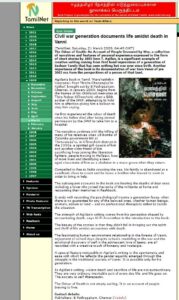Civil war generation documents life amidst death in Vanni

The Odour of Death: An Account of People Devoured by War, a collection of narratives and features of personal experience expressed in the form of short stories by 1983-born T. Agiilan, is a significant example of creative writing coming from first hand impressions of a generation of Eezham Tamils that has seen nothing but war ever since birth. Another importance of the book is its documentation of war-torn Vanni of pre 2002 era from the perspectives of a person of that land.
Agiilan’s book in Tamil, ‘Mara’naththin Vaasanai: Poar Thin’ra Chanangka’lin Kathai’, brought out by E Pathippakam, Chennai, in January 2009, begins from the frames of his childhood memories at Thiru Nakar, Ki’linochchi, when a Sikh soldier of the IPKF, attempting to hold him in affection giving him a balloon to stop him crying.
He first experienced the odour of death when his father died after being denied permission by the IPKF to take him to a hospital.
The narrative continues with the killing of many of his relatives when 18 bombs of Colombo government fell at Thiruvaiyaa’ru, in Ki’linochchi district in the 1990s, a spirited girl-cousin of him and another older friend of him sacrificing lives joining the liberation fighters, people moving to Mallaavi, loss of more lives and identifying a teen-aged classmate of him as a skeleton in a mass grave when they return.
Compelled to flee to India crossing the sea, his family is abandoned at a sandbank close to the coast and he loses a brother who braved to swim in order to bring in help.
The subsequent accounts in the book are hearing the deaths of dear ones including a lover who joined the ranks of the militants at home and recounting their memories in flashback.
It ends with recording the psychological trauma a generation faces, when there is no guarantee for any of the beloved ones, whether human beings, animals, nature or land – and no professional therapists either to tackle the situation.
The strength of Agiilan’s writing comes from his perception shaped by encountering death, says Ki Pi Aravinthan in the introduction to the book.
The beauty of the stories is that they didn’t fail in bringing out the spirit and thrill of life amidst encounters with death.
The fascinating human-environment relationship in the forests of Vanni, enjoyment of school days despite schools crumbling in the war and the emotional discovery of self in the adolescent love of teens, are all recorded with a creative touch of honesty and nostalgia.
~~
Source: Tamilnet
